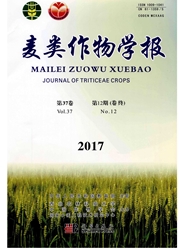

 中文摘要:
中文摘要:
通过田间试验,研究了小麦间作玉米塑料薄膜隔根(PW//C)、尼龙网隔根(NW//C)、不隔根(W//C)及单作玉米(C)和单作小麦(W)对土壤水分、棵间蒸发和水分利用效率的影响。结果表明,根系分隔显著影响作物的耗水特性,从而显著影响作物产量及水分利用效率的提高。小麦收获前,W//C、NW//C和PW//C处理玉米带土壤水分含量均高于小麦带,分别提高2.38%、3.82%和6.13%;小麦收获后,NW//C和PW//C处理玉米带土壤水分含量却均低于小麦带,分别降低5.41%和16.07%,而W//C处理玉米带和小麦带间水分差异不显著。根系分隔显著增大了间作模式的作物棵间蒸发量,NW//C和PW//C较W//C处理分别显著提高6.71%和20.13%。以单作小麦、单作玉米加权平均为对照,W//C、NW//C和PW//C处理分别显著提高经济产量33.60%、26.93%和24.69%,增大耗水量-0.2%、1.02%和6.69%,显著提高水分利用效率34.93%、26.67%和17.80%。W//C处理较NW//C和PW//C处理分别提高经济产量5.25%和7.14%,降低耗水量1.21%和6.64%,提高水分利用效率6.52%和14.54%。
 英文摘要:
英文摘要:
A field experiment was conducted from March to October in 2009 to investigate the effects of different root partition patterns( roots of intercropped wheat-maize were separated by plastic film( PW / / C),and nylon( NW/ /C),no-root-separation( W/ /C),sole wheat,and sole maize) on soil water,soil evaporation and water use efficiency( WUE) of wheat-maize intercropping system. The results indicated that the intercropping systems significantly affected the characteristic of soil water consumption that markely improved crop yield and WUE during two crops growing stage. Root partition patterns significantly decreased soil water dynamic and crop yield. Before harvesting wheat,W / / C,NW / / C and PW / / C treatments improved soil water storage of maize strip by 2. 38%,3.82% and 6. 13% than that of wheat strip,respectively. However,after harvesting wheat,NW / / C and PW / / C treatments decreased soil water storage of maize strip by 5. 41% and 16. 07% than that of wheat strip,respectively.However,no significant difference was found in soil water storage between wheat and maize strips by W / / C treatment. Root partition patterns significantly increased the soil evaporation,and NW / / C and PW / / C treatments significantly increased soil evaporation by 6. 71% and 20. 13% compared with NW / / C treatment,respectively. Compared to the weighted averages of sole wheat and maize,W / / C,NW / / C and PW / / C treatments significantly improved yield by 33. 60%,26. 93% and 24. 69%,water consumption by 0. 2%,1. 02% and 6. 69%,and water use efficiency( WUE) by 34. 93%,26. 67% and 17. 80%,respectively. Compared to NW / / C and PW / / C treatments,W / / C treatments significantly improved yield by 5. 25% and 7. 14%,decreased water consumption by 1.21% and 6. 64%,and improved WUE by 6. 52% and14. 54%,respectively.
 同期刊论文项目
同期刊论文项目
 同项目期刊论文
同项目期刊论文
 期刊信息
期刊信息
